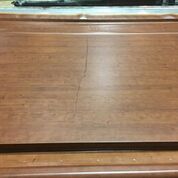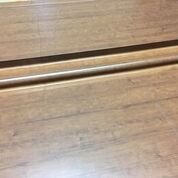Tech|Tips – 3DL: Wrinkling on Large Parts
Since the very beginning of my involvement in 3D Lamination, I’ve been aware of the problems associated with producing very long parts (4′ +) in a membrane press. One of my earliest experiences providing technical support involved a part that was 4′ wide and nearly 8′ in length. “I can’t even get 1/3 of the parts to come out acceptably”, said this frustrated producer.
So what is it about long parts that make them so difficult? For starters, 3D Laminate tends to expand when heated, especially across the width of the material. As it expands, this excess material needs somewhere to go or it becomes a wrinkle on the surface of the product. When producing smaller parts, gaps between each of the parts allows the material to stretch out any excess that was created during the heating cycle. With very large parts this excess has nowhere to go. The only solution is to eliminate the formation of excess material in the first place.
The process of eliminating these wrinkles can be a long and emotionally arduous task. The solutions will vary based on the press design, but one factor is a consideration among all of them, so we’ll start there.
Heat
As stated earlier 3D Laminate expands when heated, especially across the width of the material. The process of eliminating wrinkles starts with finding the minimum acceptable temperature and preheat time necessary to form the laminate over the substrate and activate the glue. Both time and temperature will impact how much the material expands.
Minimize/Eliminate Material Stretching During Pre-Heat (Membrane Press)
In order to eliminate stretching of 3DL during preheating, it is important to bring the membrane and 3DL together at the start of the cycle without pulling the 3DL up into the upper chamber. This is best done by creating a “belly” in the membrane as the press closes. A belly that is too large or too small both present a problem. For optimum performance, the belly needs to drop very slightly below the bottom surface of the separation frame between the membrane and 3DL.
Video:
The first segment shows a belly that is much too large and was creating wrinkles across the width of the material.
A belly that is much too small will typically lead to wrinkles down the length of the press.

The second segment shows a belly that is about right and solved the problem for this particular producer.

Looking for More Information?
Check out our Resources or Contact Us

